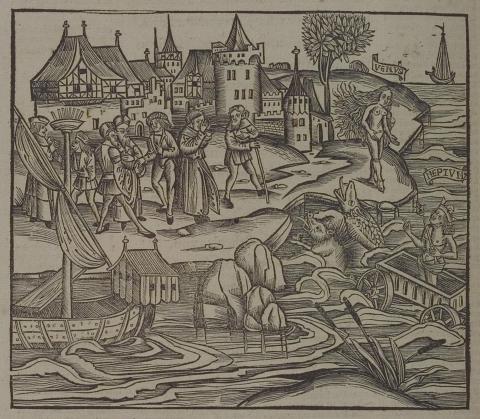Annotations
Aeneas and the followers who have agreed to continue the journey to Latium with him bid farewell to those who have decided to stay behind in the newly founded city of Acesta (765-71). A ship on the left side of the image, with a gang-plank leading from it to the shore, indicates the imminent departure of the Trojans. On the right, Venus entreats Neptune to ensure the safe travels of Aeneas (779-98); Neptune assures Venus that he will protect Aeneas and his crew. Neptune stands facing Venus, with his back to the front of his chariot (799-815). Behind his chariot, near the shore, two sea creatures, perhaps the artist's attempt at depicting whales, make up his retinue of followers (816-26). (Katy Purington)
Woodcut illustration from the “Strasbourg Vergil,” edited by Sebastian Brant: Publii Virgilii Maronis Opera cum quinque vulgatis commentariis expolitissimisque figuris atque imaginibus nuper per Sebastianum Brant superadditis (Strasbourg: Johannis Grieninger, 1502), fol. 249v, executed by an anonymous engraver under the direction of Brant.


Sebastian Brant (1458-1521) was a humanist scholar of many competencies. Trained in classics and law at the University of Basel, Brant later lectured in jurisprudence there and practiced law in his native city of Strasbourg. While his satirical poem Das Narrenschiff won him considerable standing as a writer, his role in the transmission of Virgil to the Renaissance was at least as important. In 1502 he and Strasbourg printer Johannes Grüninger produced a major edition of Virgil’s works, along with Donatus’ Life and the commentaries of Servius, Landino, and Calderini, with more than two hundred woodcut illustrations. (Annabel Patterson)